This Noticing New York post will do something unprecedented: I will turn over most of what you will be reading here to someone else's voice: the startling hearing testimony of researcher Donald Christensen. I doubt that you will be disappointed!
I'd like to think that, even if readers will be reading work authored by another, they will feel as if they they are reading one of Noticing New York's better articles. I hesitate to make that assertion because you might think I am trying to flatter myself: The insights, research upon which they are based, and the way everything is expressed in what you will be reading is superb.
State Assemblyman Kellner's Hearing on Sale of NYC Libraries
Last Thursday, June 27, 2013, Assembly Member Micah Kellner, Chair of the Committee on Libraries and Education Technology, held a public hearing at 250 Broadway in Manhattan on the sale of New York City library buildings to private developers. The better part of what you be reading constituting this post is the stunning testimony delivered at that hearing by Donald Christensen, a professional researcher.
The hearing was very well attended with many of those attending testifying quite eloquently although some, like Mr. Christensen, set a very high bar. Citizens Defending Libraries and The Committee to Save the New York Public Library were among those testifying with a slew of others about the sell-off and shrinkage of libraries around the city, including the Central Library Plan, Donnell and libraries in Brooklyn. Testimony concerned the cost of these plans, the proposed destruction of the historic, irreplaceable assets, and how the plans donot benefit the public. The sell-offs resulting in shrinkage of the library system and assets owned by the public include destruction of the famed research stacks of the 42nd Street library on Fifth Avenue behind the lions, Patience and Fortitude. I personally testified as part of Citizens Defending Libraries of which I am a co-founder. Testimony from Citizens Defending Libraries, including mine, is available at CDL's web pages)
Overall, between 50 to 60 people signed up to testify. Though the room was filled to capacity (about 130 people were there) with every seat taken, not all of those who signed up to testify made it to the hearing and some who made it to the hearing to testify were not able to wait until the end of the day to deliver their testimony orally (though they were able to submit their testimony in writing): The hearing, scheduled for 10:30 AM, got underway before 11:00 AM and lasted until just after 6:00 PM. Other than the library heads, Anthony W. Marx, president of the New York Public Library, and Linda E. Johnson, president of the Brooklyn Public Library, nobody who spoke on Thursday spoke in favor of selling the libraries.
Press Coverage
A most detailed account of the hearing from Susan Bernofsky can be found here: Friday, June 28, 2013, Saving the New York Public Library. Video of it is now up on the Assembly’s website where a transcript will also be supplied.
The best news for opponents of the library sales was that the Times coverage, by Robin Pogrebin and prominently featured in Friday’s main art section (see above), raises the hope that these issues are beginning to get the kind of coverage they deserve. Recently, Times reporter Joseph Berger worked mention of Citizens Defending Libraries (and accompanying link) into an updating story about the improved prospects for survival of the Pacific Branch library (Berger has also tracked the fate of libraries in an updating story about school sales were thwarted by community opposition). That mention was a helpful adjustment for the fact that reference to Citizens Defending Libraries had been removed from the earlier Times front page story about city libraries and schools being sold.
Ms. Progrebin’s latest article didn’t refer specifically to Citizens Defending Libraries but its theme was how NYPL president Marx has needed to retreat in the face of questions about why the NYPL was proceeding with an obviously very expensive Central Library Plan when it did not yet have a design or cost calculations. See: Critics Prompt New Review of Library Plan, June 27, 2013.
Landmark West! emailed the Times story picking out what may be its most telling line:
Lack of Response By Library Officials to the Public
I would have pointed out that Mr. Marx said that the NYPL was listening and responding to public to make adjustments to its Central Library Plan, but that when Citizens Defending Libraries met with the NYPL's Chief Operating Officer, David Offensend, (May 30, 2013), we asked Offensend to describe in exactly what ways the NYPL has incorporated public feedback in updating its plans and the list he gave in a two and half minute response was sparse, although he also emphasized that the NYPL didn't have a "final design" and was "still working at it with the architects":
During his June 27th hearing testimony Marx also mentioned the accommodation to critics of building out the stacks under Bryant Park (this was actually the first of the items when Offensend `ticked' off his list). The problem was that at the same meeting where Offensend cited this as being a revision to the plan in response to public comment he contradicted himself with an earlier statement describing the build-out as being part of the original plan.
He said that the plan had begun by 2006, perhaps as early as 2005, and that in discussion there had been concern about the amount of space available. He said the NYPL hired the Gensler architectural firm, which was looking at the space issue and that the firm said, "The thing to do to create the right amount of space is to remove the stacks, which is the main thing here, to create that much space." Offensend continued immediately (emphasis supplied):
. . . One other thing that COO David Offensend conceded at our May 30th meeting with him was that if the NYPL's calculations about space needs were incorrect, or if with growth in the future the consolidated Central Libray Plan library needed to be expanded, there was no capacity to accommodate such expansion.
Had I continued my testimony at the hearing, I would have pointed out that the NYPL's lack of response to public reaction, together with Tony Marx's math that seems to assume that taxpayer dollars spent on the CLP don't have to be calculated as a cost in any cost benefit analysis, indicate a disdain for the public. Rather similarly, in Brooklyn, the Brooklyn Public Library does not wish to accept Citizens Defending Libraries as a representative of the public while the "Friends" of the library group has been given a lead role on the Brooklyn Heights Library "Community Advisory Committee" to represent the community even when that "Friends" group apparently believes it is never allowed to disagree or take issue with the BPL.
Elected Representatives Present at the Hearing
Testimony from all the following elected officials was all highly critical of the library real estate deals: City Council members Tish James and Steve Levin, State Senator Velmanette Montgomery, State Senator Bill Perkins (by his representative, Michael Henry Adams). Those Assembly Members asking the library heads for information, including Kellner and Millman, were also highly skeptical of the planned sales.
Reportedly Dejected Ms. Johnson After Hearing
BPL's Linda Johnson seemed to attempt a friendly conversation with Councilman Levin out by the elevators right before he went in to testify critically about the BPL’s sales. Word is that the BPL's Linda Johnson was morose and cranky as she rode down in the elevator leaving the hearing, complaining about all the opposition to her planned library sales. She was headed for a meeting of the BPL trustees later that evening. There at that 5:30 PM meeting she was greeted by community activists who held up signs about saving the Pacific Branch. They stayed for most of the trustees meeting, but, according to the reports I received, unless Ms. Johnson saved her remarks for the very end, she never acknowledged the activists present, nor told the trustees anything about that day’s hearing.
Through To the Bitter End
While the Times picked out the testimony of Edmund Morris, the Pulitzer Prize and National Book Award-winning writer and biographer of Theodore Roosevelt, who testified early in the day, as being of exceptional interest, as indeed it was, there was superb testimony throughout the day and you had to wait until the very end to hear some of the best of it, including Mr. Christensen’s.
Mr. Christensen was on one of the very last panels with former librarian Rita Bott who also provided some especially insightful testimony that I should perhaps publish in another follow-up. A coincidence: It turned out that, as a librarian, Ms. Bott had assisted Mr. Christiansen with research years ago but they had never formally met.
Because the testimony from Mr. Christensen that follows below is as long as it is I have not observed the usual Noticing New York convention of indenting to indicate that the text appearing is supplied by someone else. Also, to assist the reader with some "wayfinding" guideposts I have myself provided some subheading interjected between soem of the paragraphs.
Here then, without further ado, is the testimony (video available at CDL's YouTube Channel) Mr. Christensen presented.
TESTIMONY FOR COMMITTEE ON LIBRARIES AND EDUCATION TECHNOLOGY HEARING JUNE 27, 2013 PRESENTED BY DONALD CHRISTENSEN
Thank you for this opportunity to provide information I have concerning the topic of this public hearing. This hearing serves as a unique platform to create a public record of the facts, concerns and probable impact of the library's radical plans for reducing ready access to the library's resources for members of the public that the charter of the library promises to serve. Perhaps this public record will be reviewed by the people who are orchestrating this radical - and destructive - plan because until today there has been virtually no input allowed from anyone outside the small cadre of people intent on a singular agenda that has little to do with the goals that until recently guided this once-great institution.
Going Back In Time: The NYPL Standards For Serving The Public That Used To Apply
To prepare for today's testimony I read through the papers of the former Director of the library during the years of the formation of the Mid-Manhattan Library as it exists today at 40th Street and Fifth Avenue. His name was John Mackenzie Cory. He was on the staff of the library from the early 1950s until the late 1970s. All of his papers covering the transformation of the Mid-Manhattan building from the department store known as Arnold Constable are preserved in a large file box in the manuscript department of the Main Library building. That collection of papers includes all the correspondence, personal memos of everything from telephone conversations to notes gathered at lunch meetings, copies of internal reports from various Trustee committees, copies of legal interpretations concerning the Mid-Manhattan property as a real estate investment as well as various "white papers" and "confidential reports" that define the sequence of events and thoughts that show the path for the development of that facility. The records of Directors of the Library are sealed from public view for 20 years. That means we won't be able to access such records of the current director and those of the recent past to find out exactly what they have been up to for another 20 years, in which case it might be too late. But we have Mr. Cory's papers and they reveal a lot. I also had the opportunity to review the minutes of the Branch Library Council, which oversees a part of the actions of the branch libraries, including Mid-Manhattan, from the years 1949 through 2002. Those minutes and the other papers in the Branch Library Council file box at the manuscript department also reveal some interesting things.
While I went through these papers I took copious notes and had copies made of salient documents. Unfortunately, I cannot share with you copies of those documents. I have them with me, but I cannot copy them or quote from them for any type of publication (including the 20 copies of this testimony) without permission of the library. I have not been able to secure permissions. So I will have to paraphrase what I found in those papers.
There are two basic issues I'd like to cover today in the short amount of time I have. First, the goals and intentions of the Mid-Manhattan library as defined by the people of John Mckenzie Cory's era in comparison to what the current regime wants to deliver to the people of New York. Second, to look at the Mid-Manhattan property as piece of real estate. As everyone in this room knows, this whole current plan is really a real estate story, apparently designed to make someone really, really rich while impoverishing the cultural and intellectual texture of the city of New York.
Why Mid-Mahattan Was Developed And Serves The Public The Way That It Does
First, why Mid-Manhattan was developed. Since the late 1940s the Library wanted to move the small circulating facility out of the main building so that the main building could concentrate on the research aspect of the library that was the basis of its formation as opposed to the goals of the branch libraries. They first considered other ways of expanding the space within the main library. For example, there was a plan drawn up to tunnel under the terraces surrounding the building. That plan was scratched because they wanted a general circulating/general research library that was both visible and easily accessible. They did not want to hide it within the marble fortress of the Main Library. Also, they wanted a facility at a location nearby the main building. The idea was that if someone's research need was beyond the resources of a general research library, a patron could readily be sent to the main library and have their research needs handled immediately.
In 1961, the building housing the Arnold Constable department store came on the market. The department store did not own the building and never had. The store was just a tenant and in 1961 they had a lease that would not expire until 1979. Still, the library bought the building with the specific intention of taking over the building in 1979. The department store went out of business in 1975 and vacated the building. In 1967 the department store vacated the top three floors of the building and the first manifestation of the Mid Manhattan library branch opened on those top three floors in 1971. After the department store completely vacated the building, a series of recommendations were made about how to use the space. There was a lot of pressure to rent out the first floor for commercial use to get money to run the library. But a stronger faction within the library argued that such a thing would go against the goal of making the library fully visible from the street and readily accessible right off the sidewalk. To make it even more inviting they increased the size of the window on the façade of the building so that people could see in and see that it was a welcoming place to enter.
Another option that was rejected was the possibility of purchasing the Columbia University Club building on West 43rd Street, which was on the market for a time prior to the full expansion into Constable building. That option was rejected because the 43rd Street location was not visible enough.
After the commitment to the Mid-Manhattan along with its street level openness and easy accessibility, millions of visitors found that the concept has been very successful.
Accessibility and Burying Replacement Library Space Where The Research Stacks Now Exist
But now we are faced with a different idea. This idea strives to hide the general library deep in the bowels of a formidable building behind three massive walls of marble and far, far away from ready access from the street. This idea more closely matches the idea of burrowing under the terraces that an earlier - and wiser - generation of library leaders rejected as inappropriate for serving the general public. And how will this hidden facility welcome people into it or even let people know it is there? I doubt very much that they will put a sign over Stephen Schwarzman's name on the building to tell people what they might find inside.
As far as accessibility goes, this plan is a nightmare. I counted how many stairs and how many strides it would take to get to that location. Now, I might point out, it takes about 10 strides at the Mid-Manhattan library to get from the street into the actual library space - and it's on one level. In contrast, you have to climb 29 stairs and you have to take 62 strides to get from the sidewalk to the first door of the building's entrance. Then you have to take another 88 strides to get from the first door, traveling through two more doors to finally get to the top of Sir Norman Foster's flamboyant and vulgar staircase to look up at a seven-story high empty atrium and then climb down more stairs to reach the main level of the so-called library. It would take half a day to get to and from that space and only if you are in good shape.
But before you could get to Sir Norman's atrium, you would be forced to pass through one small door to get into what is now the Gottsman exhibition space and then through another small door at the other end of the Gottsman space before finally getting to Sir Norman's staircase when to begin your descent. Those two small doors supposedly are to serve both as the ingress and egress to and from the atrium space. At the Mid-Manhattan building, in contrast, there are three doors to enter and in different locations there are five doors to exit. And even then there are sometimes lines to get in or out. But Sir Norman's design doesn't take such traffic flow into consideration. Maybe Sir Norman doesn't know what it takes to get a million people a year in and out of a building space if there is only one door for both paths of action. The library has produced a video* that shows how easy it would be to get to the Sir Norman's atrium by seeming to show you floating through these little doors like Peter Pan with no other people around and no obstructions. In reality, it would more likely look like the army of cards in Alice in Wonderland slamming up against each other to get through the White Rabbit's little door. I can imagine that Sir Norman doesn't have to worry about crowds of ingress and egress when he visits the library building because I'm sure he is gestured in with: "After you, Sir Norman." When I look at the lack of doors to accommodate any reasonable type of ingress and egress flow of people, I notice that there are spaces at the rear wall of the Astor Hall that separates the Hall from the Gottesman Exhibition Hall that could be knocked out and more doors put in. Although the Astor Hall has an interior landmark status, I understand that the landmark definition does not extend to that back wall. I wonder if the current leaders of the library and Sir Norman would have any problem with knocking out portions of that wall - and vandalizing that space -- once they realize that people couldn't all get in and out of the single small door that is there now?
Sir Norman's Vision?
In short, what we are getting here is the closure of a completely open democratic space and in its place we're getting a hard-to-get-to and hard-to-access area that's really designed to keep people out for elitist use by people who have the time to get there and the knowledge of where it's hidden. And let's be frank here, who could look at that huge atrium space and not see it for what it really is: A dramatic party room to be used occasionally by a handful of rich people. All fully equipped with a Sir Norman staircase to enter onto and sashay down so that party goers gathered below can admire the clothes of other rich people.
And, by the way, why couldn't the library leadership find an American architect? After all, the trustees of the original building were able to find American architects. But I guess it's less fun to say "I'm taking the B train to Union Square to meet with the architects" than to say "I have to go to London to meet with Sir Norman."
Lost, Inaccessible Library Materials (Including Materials On The NYPL Itself)
This whole Sir Norman dynamic sums up the elitist tone of this entire Central Plan. This new space isn't for the little people. It just another club room for today's moneyed oligarchs, their avatars and sycophants.
And to claim that the traditional use of the Main Library as a superb research center has been maintained even though most of the books have been moved elsewhere - like New Jersey - is a total lie. While I have used that research library for over 30 years, my recent experience shows exactly how wrong-headed and dangerous this method is proving to be. When you go to the main library, you don't know what materials are on-site or off-site. The on-line catalog accessible via the internet at home is of little help. You can try to order off-site materials via the internet, but the library cannot promise when the materials will be ready to be examined. In fact, if you ask for them to arrive on a certain date, you cannot ask whether or not they will be there until AFTER the date is passed! (See ATTACHMENT A.) In addition, because there is no librarian to assist you in navigating through the search process, you are often sent the wrong materials. Moreover, a lot of materials have already been lost. For example, I wanted to look at the New York Public Library's Annual Reports from 1958 through 1962 to see what was said about the purchase of the building that is today Mid-Manhattan. Well, those volumes have been lost. (See ATTACHMENT B.) I had to be sent to the Butler Library at Columbia University to look at them. (See ATTACHMENT C.) The New York Public Library has LOST the documents of their own history. Tragically, it's not too surprising since the current leadership of the library apparently has total contempt for the treasures in their care as they throw these materials up and down the New Jersey Turnpike in a cavalier fashion. I can report with confidence that the librarians working at the Main Library are completely frustrated with this nonsensical system that will guarantee further deterioration of the collection as it travels back and forth from storage in another state instead of just traveling up and down on small elevators from the stacks. And why? Again so that a few rich people can have another dramatic party room?
Delving Into Real Estate Deal Aspects of Central Library Plan
The successful and ideal profile of the existing Mid-Manhattan building as fulfilling the goals of being a visible, accessible, democratically welcoming center located right on the street compared to the hidden, inaccessible, elitist nature of the proposed plan to move within the Main Building butts up against the reality of the real estate of the Mid-Manhattan building. This prime property is ripe for development. But who would get it? Who is poised to make the big money with its ownership? But more importantly, why should the library give it up since, obviously, they could never be able to recapture such real estate if the nature of libraries changes again at some time in the future. Plus, considering the library's past failures in successfully getting good prices for the real estate they have already sold, why should they be trusted not to throw this one away as well?
The unique placement of the Mid-Manhattan buidling finds it at the edge of the Bloomberg initative calling for the updating of buildings within what is called the East Midtown Rezoning Target Zone. Attached is a map of that area. (See ATTACHMENT D.) Shown on the map are shaded buildings that were built prior to 1961 and are particularly targeted for replacement with more modern and taller buildings. You will see on this map that the building directly adjacent to the Mid-Manhattan building to the east is one of those shaded buildings - 10 East 40th Street. The Mid-Manhattan building occupies 2-8 East 40th Street. The library building itself is NOT within the Target Zone, but, again, the adjoining property is.
The Wohls
10 East 40th Street is owned by a group headed by real estate mogul Larry A. Wohl. Wohl's father and Wohl's father's partner Norman Levy bought 10 East 40th in the mid 70s. The two buildings - the library building and 10 East 40th - has a long and complex interwoven history that is too complicated to get into here. The two buildings were built by the same man - Frederick Vanderbilt - who owned them until death in 1938. There are aspects of the two buildings that overlap. Because of this interwoven connection, Norman Levy and Wohl's father were in constant contact with John Mackenzie Cory and other library executives over one matter or another affecting both buildings.
Then in the mid 1970s after the department store decided to vacate the building and before the commitment was made to fully develop the Mid-Manhattan branch, Levy and Wohl made a very generous offer to buy the building. This sent the library leaders to assess the situation seriously. They drew up an analysis of 6 options, including selling the building to Levy and Wohl. The library as well as the whole city was in dire financial straits at the time. But in the end the library leaders took the high road. They recognized that the building offered the best option for the goals they wanted to achieve to serve the needs of a general library. They turned down the purchase offer to follow the ideals of the institution - visibility and accessibility, no matter what the cost. Even though they didn't really have the money at the time.
Obviously, today if 10 East 40th could be a target for demolition and replacement with a super skyscraper, then a new building that could occupy both 10 East 40th and the Mid-Manhattan building site would make that super skyscraper even more super. I doubt that that observation has escaped Larry Wohl. And he has the money to do it. In addition, Mayor Bloomberg has apparently jumped on the "tear down the Mid-Manhattan building" bandwagon. Attached is an "agreement" from 2008 from the Mayor's office allowing the library to vacate the Mid-Manhattan building and sell it. This so-called "agreement" looks more like a commandment than an agreement, since no one from the library signed it. (See ATTACHMENT E.)
Has that observation of linking the two properties of Mid-Manhattan and 10 East 40 escaped the notice of the current leaders of the library? I doubt it. But, would they stick to the principles that their predecessors under the leadership of John Mackenzie Cory showed when they turned down an offer of ready cash from Wohl's father in order to fulfill the goals of the institution of reaching out to the users of the public library by having a space visible and easily accessible. Sadly, I doubt that as well.
They'd rather have the hidden Sir Norman party room kept pristine by keeping people out through three barriers of marble walls and time-consuming journeys to keep it available only to people with a lot of time and cut out such groups as lunchtime users who now run quickly in and out of Mid-Manhattan.
I don't know if Larry Wohl has maintained the type of constant contact with today's library leadership that his father and Norman Levy enjoyed with John Mackenzie Cory. We won't know for another 20 years when we will be able to examine the papers of Mr. Marx and his advisers.
Wohl's Writing On The Wall?
But the other day I got a little clue. Walking past the two buildings where they join on East 40th Street -I noticed that a large advertising sign for Mr. Wohl's leasing corporation, Joseph P. Day Realty, was announcing space for lease in 10 East 40th. The sign extends far into the side of the library building. (See ATTACHMENTS F and G.) This sign, in other words, encroaches on the library property, apparently with impunity. Is Mr. Wohl already assuming ownership of the library building? Are the leaders of the library already assuming that that will be the case?
Is it much of a leap to imagine how much richer Wohl would become with control of that corner of real estate? And is it much of a leap to imagine how much less access the people of New York will have to library services as a result?
As the library continues to give away its real estate to make others rich, the losers are the people of New York.
* * * *
And that, dear friends of Noticing New York, is the startling testimony that was presented by professional researcher Donald Christensen at Micah Kellner's June 27, 2013 Assembly committee hearing about the sale of libraries in New York City.
Video is below or, best way to see it, available at CDL's YouTube Channel.
I'd like to think that, even if readers will be reading work authored by another, they will feel as if they they are reading one of Noticing New York's better articles. I hesitate to make that assertion because you might think I am trying to flatter myself: The insights, research upon which they are based, and the way everything is expressed in what you will be reading is superb.
State Assemblyman Kellner's Hearing on Sale of NYC Libraries
 |
| Above, Assembly Members Micah Kellner and Joan Millman listen to NYPL President Anthony Marx's testimony. Photo from Jonathan Barkey |
The hearing was very well attended with many of those attending testifying quite eloquently although some, like Mr. Christensen, set a very high bar. Citizens Defending Libraries and The Committee to Save the New York Public Library were among those testifying with a slew of others about the sell-off and shrinkage of libraries around the city, including the Central Library Plan, Donnell and libraries in Brooklyn. Testimony concerned the cost of these plans, the proposed destruction of the historic, irreplaceable assets, and how the plans donot benefit the public. The sell-offs resulting in shrinkage of the library system and assets owned by the public include destruction of the famed research stacks of the 42nd Street library on Fifth Avenue behind the lions, Patience and Fortitude. I personally testified as part of Citizens Defending Libraries of which I am a co-founder. Testimony from Citizens Defending Libraries, including mine, is available at CDL's web pages)
Overall, between 50 to 60 people signed up to testify. Though the room was filled to capacity (about 130 people were there) with every seat taken, not all of those who signed up to testify made it to the hearing and some who made it to the hearing to testify were not able to wait until the end of the day to deliver their testimony orally (though they were able to submit their testimony in writing): The hearing, scheduled for 10:30 AM, got underway before 11:00 AM and lasted until just after 6:00 PM. Other than the library heads, Anthony W. Marx, president of the New York Public Library, and Linda E. Johnson, president of the Brooklyn Public Library, nobody who spoke on Thursday spoke in favor of selling the libraries.
Press Coverage
 |
| Times story on Marx and the hearing |
The best news for opponents of the library sales was that the Times coverage, by Robin Pogrebin and prominently featured in Friday’s main art section (see above), raises the hope that these issues are beginning to get the kind of coverage they deserve. Recently, Times reporter Joseph Berger worked mention of Citizens Defending Libraries (and accompanying link) into an updating story about the improved prospects for survival of the Pacific Branch library (Berger has also tracked the fate of libraries in an updating story about school sales were thwarted by community opposition). That mention was a helpful adjustment for the fact that reference to Citizens Defending Libraries had been removed from the earlier Times front page story about city libraries and schools being sold.
Ms. Progrebin’s latest article didn’t refer specifically to Citizens Defending Libraries but its theme was how NYPL president Marx has needed to retreat in the face of questions about why the NYPL was proceeding with an obviously very expensive Central Library Plan when it did not yet have a design or cost calculations. See: Critics Prompt New Review of Library Plan, June 27, 2013.
Landmark West! emailed the Times story picking out what may be its most telling line:
Mr. Kellner questioned, “If we don’t have a design yet and we don’t know cost, why has the N.Y.P.L. applied for and been granted building permits?”The math in Marx's statements about how he was calculating that there was public benefit to the CLP also did not seem to work out unless one ignores and does not treat enormous taxpayer expenditures ($150 million) as being an expense. In my testimony, which followed President Marx's, I offered to comment on Mr. Marx's remarks but that didn't happen, given time constraints and the long list of those signed up to speak next.
Lack of Response By Library Officials to the Public
I would have pointed out that Mr. Marx said that the NYPL was listening and responding to public to make adjustments to its Central Library Plan, but that when Citizens Defending Libraries met with the NYPL's Chief Operating Officer, David Offensend, (May 30, 2013), we asked Offensend to describe in exactly what ways the NYPL has incorporated public feedback in updating its plans and the list he gave in a two and half minute response was sparse, although he also emphasized that the NYPL didn't have a "final design" and was "still working at it with the architects":
• The NYPL will "use more of the historic stack materials in the new design" to "memorialize what they look like"When we get to Mr. Christensen's testimony, remember the points above about the flow of pedestrians and crowds through the building and signage, wayfinding and visitor experience.
• "People have expressed concern about how people will travel through the building" and accommodation of the larger number of people the NYPL has spent time "designing what the architects call the circulation, meaning how people move around and through the building" with "considerably more square footage open to the public. . so we are working hard on that"
• Signage and wayfinding, ways to improve the visitor experience.
• The NYPL, as of September, "agreed to a build out a portion of the Bryant Park stack to maintain many more books on site"
During his June 27th hearing testimony Marx also mentioned the accommodation to critics of building out the stacks under Bryant Park (this was actually the first of the items when Offensend `ticked' off his list). The problem was that at the same meeting where Offensend cited this as being a revision to the plan in response to public comment he contradicted himself with an earlier statement describing the build-out as being part of the original plan.
He said that the plan had begun by 2006, perhaps as early as 2005, and that in discussion there had been concern about the amount of space available. He said the NYPL hired the Gensler architectural firm, which was looking at the space issue and that the firm said, "The thing to do to create the right amount of space is to remove the stacks, which is the main thing here, to create that much space." Offensend continued immediately (emphasis supplied):
And the librarians were like, well, `we'd have to figure out where to put the books.' And we did have that second level underneath Bryant Park, and we did calculate that, fully built out, it could accommodate about the same number of stacks that were in the stacks. So that was part of the original plan. The librarians were very excited about it because they said that nobody uses those books very much, anyway.So was building out the stacks actually part of the original plan or one of the NYPL's very few ostensible responses to public feedback? I offer the above Offensend quotes without endorsement of whether I think the information stated in them is true, only to note the information given and the contradictions. The other problem with building out the supplemental stacks under Bryant Park now in order to accommodate more books is that use of those stacks was always, for decades, the plan to accommodate future growth and needs, not present ones. It was supposed to accommodate at least another ten years of future need. . . .
. . . One other thing that COO David Offensend conceded at our May 30th meeting with him was that if the NYPL's calculations about space needs were incorrect, or if with growth in the future the consolidated Central Libray Plan library needed to be expanded, there was no capacity to accommodate such expansion.
Had I continued my testimony at the hearing, I would have pointed out that the NYPL's lack of response to public reaction, together with Tony Marx's math that seems to assume that taxpayer dollars spent on the CLP don't have to be calculated as a cost in any cost benefit analysis, indicate a disdain for the public. Rather similarly, in Brooklyn, the Brooklyn Public Library does not wish to accept Citizens Defending Libraries as a representative of the public while the "Friends" of the library group has been given a lead role on the Brooklyn Heights Library "Community Advisory Committee" to represent the community even when that "Friends" group apparently believes it is never allowed to disagree or take issue with the BPL.
Elected Representatives Present at the Hearing
Testimony from all the following elected officials was all highly critical of the library real estate deals: City Council members Tish James and Steve Levin, State Senator Velmanette Montgomery, State Senator Bill Perkins (by his representative, Michael Henry Adams). Those Assembly Members asking the library heads for information, including Kellner and Millman, were also highly skeptical of the planned sales.
Reportedly Dejected Ms. Johnson After Hearing
BPL's Linda Johnson seemed to attempt a friendly conversation with Councilman Levin out by the elevators right before he went in to testify critically about the BPL’s sales. Word is that the BPL's Linda Johnson was morose and cranky as she rode down in the elevator leaving the hearing, complaining about all the opposition to her planned library sales. She was headed for a meeting of the BPL trustees later that evening. There at that 5:30 PM meeting she was greeted by community activists who held up signs about saving the Pacific Branch. They stayed for most of the trustees meeting, but, according to the reports I received, unless Ms. Johnson saved her remarks for the very end, she never acknowledged the activists present, nor told the trustees anything about that day’s hearing.
Through To the Bitter End
While the Times picked out the testimony of Edmund Morris, the Pulitzer Prize and National Book Award-winning writer and biographer of Theodore Roosevelt, who testified early in the day, as being of exceptional interest, as indeed it was, there was superb testimony throughout the day and you had to wait until the very end to hear some of the best of it, including Mr. Christensen’s.
Mr. Christensen was on one of the very last panels with former librarian Rita Bott who also provided some especially insightful testimony that I should perhaps publish in another follow-up. A coincidence: It turned out that, as a librarian, Ms. Bott had assisted Mr. Christiansen with research years ago but they had never formally met.
Because the testimony from Mr. Christensen that follows below is as long as it is I have not observed the usual Noticing New York convention of indenting to indicate that the text appearing is supplied by someone else. Also, to assist the reader with some "wayfinding" guideposts I have myself provided some subheading interjected between soem of the paragraphs.
Here then, without further ado, is the testimony (video available at CDL's YouTube Channel) Mr. Christensen presented.
TESTIMONY FOR COMMITTEE ON LIBRARIES AND EDUCATION TECHNOLOGY HEARING JUNE 27, 2013 PRESENTED BY DONALD CHRISTENSEN
Thank you for this opportunity to provide information I have concerning the topic of this public hearing. This hearing serves as a unique platform to create a public record of the facts, concerns and probable impact of the library's radical plans for reducing ready access to the library's resources for members of the public that the charter of the library promises to serve. Perhaps this public record will be reviewed by the people who are orchestrating this radical - and destructive - plan because until today there has been virtually no input allowed from anyone outside the small cadre of people intent on a singular agenda that has little to do with the goals that until recently guided this once-great institution.
Going Back In Time: The NYPL Standards For Serving The Public That Used To Apply
To prepare for today's testimony I read through the papers of the former Director of the library during the years of the formation of the Mid-Manhattan Library as it exists today at 40th Street and Fifth Avenue. His name was John Mackenzie Cory. He was on the staff of the library from the early 1950s until the late 1970s. All of his papers covering the transformation of the Mid-Manhattan building from the department store known as Arnold Constable are preserved in a large file box in the manuscript department of the Main Library building. That collection of papers includes all the correspondence, personal memos of everything from telephone conversations to notes gathered at lunch meetings, copies of internal reports from various Trustee committees, copies of legal interpretations concerning the Mid-Manhattan property as a real estate investment as well as various "white papers" and "confidential reports" that define the sequence of events and thoughts that show the path for the development of that facility. The records of Directors of the Library are sealed from public view for 20 years. That means we won't be able to access such records of the current director and those of the recent past to find out exactly what they have been up to for another 20 years, in which case it might be too late. But we have Mr. Cory's papers and they reveal a lot. I also had the opportunity to review the minutes of the Branch Library Council, which oversees a part of the actions of the branch libraries, including Mid-Manhattan, from the years 1949 through 2002. Those minutes and the other papers in the Branch Library Council file box at the manuscript department also reveal some interesting things.
While I went through these papers I took copious notes and had copies made of salient documents. Unfortunately, I cannot share with you copies of those documents. I have them with me, but I cannot copy them or quote from them for any type of publication (including the 20 copies of this testimony) without permission of the library. I have not been able to secure permissions. So I will have to paraphrase what I found in those papers.
There are two basic issues I'd like to cover today in the short amount of time I have. First, the goals and intentions of the Mid-Manhattan library as defined by the people of John Mckenzie Cory's era in comparison to what the current regime wants to deliver to the people of New York. Second, to look at the Mid-Manhattan property as piece of real estate. As everyone in this room knows, this whole current plan is really a real estate story, apparently designed to make someone really, really rich while impoverishing the cultural and intellectual texture of the city of New York.
Why Mid-Mahattan Was Developed And Serves The Public The Way That It Does
First, why Mid-Manhattan was developed. Since the late 1940s the Library wanted to move the small circulating facility out of the main building so that the main building could concentrate on the research aspect of the library that was the basis of its formation as opposed to the goals of the branch libraries. They first considered other ways of expanding the space within the main library. For example, there was a plan drawn up to tunnel under the terraces surrounding the building. That plan was scratched because they wanted a general circulating/general research library that was both visible and easily accessible. They did not want to hide it within the marble fortress of the Main Library. Also, they wanted a facility at a location nearby the main building. The idea was that if someone's research need was beyond the resources of a general research library, a patron could readily be sent to the main library and have their research needs handled immediately.
In 1961, the building housing the Arnold Constable department store came on the market. The department store did not own the building and never had. The store was just a tenant and in 1961 they had a lease that would not expire until 1979. Still, the library bought the building with the specific intention of taking over the building in 1979. The department store went out of business in 1975 and vacated the building. In 1967 the department store vacated the top three floors of the building and the first manifestation of the Mid Manhattan library branch opened on those top three floors in 1971. After the department store completely vacated the building, a series of recommendations were made about how to use the space. There was a lot of pressure to rent out the first floor for commercial use to get money to run the library. But a stronger faction within the library argued that such a thing would go against the goal of making the library fully visible from the street and readily accessible right off the sidewalk. To make it even more inviting they increased the size of the window on the façade of the building so that people could see in and see that it was a welcoming place to enter.
Another option that was rejected was the possibility of purchasing the Columbia University Club building on West 43rd Street, which was on the market for a time prior to the full expansion into Constable building. That option was rejected because the 43rd Street location was not visible enough.
After the commitment to the Mid-Manhattan along with its street level openness and easy accessibility, millions of visitors found that the concept has been very successful.
Accessibility and Burying Replacement Library Space Where The Research Stacks Now Exist
But now we are faced with a different idea. This idea strives to hide the general library deep in the bowels of a formidable building behind three massive walls of marble and far, far away from ready access from the street. This idea more closely matches the idea of burrowing under the terraces that an earlier - and wiser - generation of library leaders rejected as inappropriate for serving the general public. And how will this hidden facility welcome people into it or even let people know it is there? I doubt very much that they will put a sign over Stephen Schwarzman's name on the building to tell people what they might find inside.
As far as accessibility goes, this plan is a nightmare. I counted how many stairs and how many strides it would take to get to that location. Now, I might point out, it takes about 10 strides at the Mid-Manhattan library to get from the street into the actual library space - and it's on one level. In contrast, you have to climb 29 stairs and you have to take 62 strides to get from the sidewalk to the first door of the building's entrance. Then you have to take another 88 strides to get from the first door, traveling through two more doors to finally get to the top of Sir Norman Foster's flamboyant and vulgar staircase to look up at a seven-story high empty atrium and then climb down more stairs to reach the main level of the so-called library. It would take half a day to get to and from that space and only if you are in good shape.
 |
| (Added by NNY 7/4/'13) NYPL Architectural rendering of second and last of two similarly sized small doors that would lead to what was formerly the research stack space |
[* (Added by NNY 7/4/'13) There is a five minute NYPL produced video "A First Look at NYPL's Central Library Plan" that contains the Peter Pan fly through accelerated to finish in 30 seconds (just the 30 second fly through is available here: "NYPL's accelerated Peter Pan fly through a single door.") Viewers are cautioned that the film is very deceptive in it depiction of space and some other respects, something that Noticing New York will have to deal with in a subsequent post. The NYPL's also has a one-minute version of the fly through on its site titled "Explore NYPL's 42nd Street Renovation."]Certainly, the distance from the sidewalk to Sir Norman's atrium would be an insurmountable expedition for a lot of people who currently use the Mid-Manhattan location with ease. And that doesn't even begin to address the needs of disabled people. Will people in wheelchairs be sent on an excursion to 42nd Street and up and down ramps and elevators instead of simply traveling directly off the street like they do now at Mid-Manhattan. Maybe the library could have Sir Norman design a sign to hang out front to express what they might really mean with this obstacle path for disabled people: "No cripples wanted."
| (Added by NNY 7/4/'13) What it looks like when more people use another of the library's similarly sized doors |
 |
| (Added by NNY 7/4/'13) NYPL rendering from the inside showing the one small single door entrance. |
In short, what we are getting here is the closure of a completely open democratic space and in its place we're getting a hard-to-get-to and hard-to-access area that's really designed to keep people out for elitist use by people who have the time to get there and the knowledge of where it's hidden. And let's be frank here, who could look at that huge atrium space and not see it for what it really is: A dramatic party room to be used occasionally by a handful of rich people. All fully equipped with a Sir Norman staircase to enter onto and sashay down so that party goers gathered below can admire the clothes of other rich people.
And, by the way, why couldn't the library leadership find an American architect? After all, the trustees of the original building were able to find American architects. But I guess it's less fun to say "I'm taking the B train to Union Square to meet with the architects" than to say "I have to go to London to meet with Sir Norman."
Lost, Inaccessible Library Materials (Including Materials On The NYPL Itself)
This whole Sir Norman dynamic sums up the elitist tone of this entire Central Plan. This new space isn't for the little people. It just another club room for today's moneyed oligarchs, their avatars and sycophants.
And to claim that the traditional use of the Main Library as a superb research center has been maintained even though most of the books have been moved elsewhere - like New Jersey - is a total lie. While I have used that research library for over 30 years, my recent experience shows exactly how wrong-headed and dangerous this method is proving to be. When you go to the main library, you don't know what materials are on-site or off-site. The on-line catalog accessible via the internet at home is of little help. You can try to order off-site materials via the internet, but the library cannot promise when the materials will be ready to be examined. In fact, if you ask for them to arrive on a certain date, you cannot ask whether or not they will be there until AFTER the date is passed! (See ATTACHMENT A.) In addition, because there is no librarian to assist you in navigating through the search process, you are often sent the wrong materials. Moreover, a lot of materials have already been lost. For example, I wanted to look at the New York Public Library's Annual Reports from 1958 through 1962 to see what was said about the purchase of the building that is today Mid-Manhattan. Well, those volumes have been lost. (See ATTACHMENT B.) I had to be sent to the Butler Library at Columbia University to look at them. (See ATTACHMENT C.) The New York Public Library has LOST the documents of their own history. Tragically, it's not too surprising since the current leadership of the library apparently has total contempt for the treasures in their care as they throw these materials up and down the New Jersey Turnpike in a cavalier fashion. I can report with confidence that the librarians working at the Main Library are completely frustrated with this nonsensical system that will guarantee further deterioration of the collection as it travels back and forth from storage in another state instead of just traveling up and down on small elevators from the stacks. And why? Again so that a few rich people can have another dramatic party room?
 |
| ATTACHMENT A- click to enlarge |
.jpg) |
| ATTACHMENT B- click to enlarge |
.jpg) |
| ATTACHMENT C- click to enlarge |
Delving Into Real Estate Deal Aspects of Central Library Plan
The successful and ideal profile of the existing Mid-Manhattan building as fulfilling the goals of being a visible, accessible, democratically welcoming center located right on the street compared to the hidden, inaccessible, elitist nature of the proposed plan to move within the Main Building butts up against the reality of the real estate of the Mid-Manhattan building. This prime property is ripe for development. But who would get it? Who is poised to make the big money with its ownership? But more importantly, why should the library give it up since, obviously, they could never be able to recapture such real estate if the nature of libraries changes again at some time in the future. Plus, considering the library's past failures in successfully getting good prices for the real estate they have already sold, why should they be trusted not to throw this one away as well?
The unique placement of the Mid-Manhattan buidling finds it at the edge of the Bloomberg initative calling for the updating of buildings within what is called the East Midtown Rezoning Target Zone. Attached is a map of that area. (See ATTACHMENT D.) Shown on the map are shaded buildings that were built prior to 1961 and are particularly targeted for replacement with more modern and taller buildings. You will see on this map that the building directly adjacent to the Mid-Manhattan building to the east is one of those shaded buildings - 10 East 40th Street. The Mid-Manhattan building occupies 2-8 East 40th Street. The library building itself is NOT within the Target Zone, but, again, the adjoining property is.
.jpg) |
| ATTACHMENT D- click to enlarge |
10 East 40th Street is owned by a group headed by real estate mogul Larry A. Wohl. Wohl's father and Wohl's father's partner Norman Levy bought 10 East 40th in the mid 70s. The two buildings - the library building and 10 East 40th - has a long and complex interwoven history that is too complicated to get into here. The two buildings were built by the same man - Frederick Vanderbilt - who owned them until death in 1938. There are aspects of the two buildings that overlap. Because of this interwoven connection, Norman Levy and Wohl's father were in constant contact with John Mackenzie Cory and other library executives over one matter or another affecting both buildings.
Then in the mid 1970s after the department store decided to vacate the building and before the commitment was made to fully develop the Mid-Manhattan branch, Levy and Wohl made a very generous offer to buy the building. This sent the library leaders to assess the situation seriously. They drew up an analysis of 6 options, including selling the building to Levy and Wohl. The library as well as the whole city was in dire financial straits at the time. But in the end the library leaders took the high road. They recognized that the building offered the best option for the goals they wanted to achieve to serve the needs of a general library. They turned down the purchase offer to follow the ideals of the institution - visibility and accessibility, no matter what the cost. Even though they didn't really have the money at the time.
Obviously, today if 10 East 40th could be a target for demolition and replacement with a super skyscraper, then a new building that could occupy both 10 East 40th and the Mid-Manhattan building site would make that super skyscraper even more super. I doubt that that observation has escaped Larry Wohl. And he has the money to do it. In addition, Mayor Bloomberg has apparently jumped on the "tear down the Mid-Manhattan building" bandwagon. Attached is an "agreement" from 2008 from the Mayor's office allowing the library to vacate the Mid-Manhattan building and sell it. This so-called "agreement" looks more like a commandment than an agreement, since no one from the library signed it. (See ATTACHMENT E.)
Has that observation of linking the two properties of Mid-Manhattan and 10 East 40 escaped the notice of the current leaders of the library? I doubt it. But, would they stick to the principles that their predecessors under the leadership of John Mackenzie Cory showed when they turned down an offer of ready cash from Wohl's father in order to fulfill the goals of the institution of reaching out to the users of the public library by having a space visible and easily accessible. Sadly, I doubt that as well.
They'd rather have the hidden Sir Norman party room kept pristine by keeping people out through three barriers of marble walls and time-consuming journeys to keep it available only to people with a lot of time and cut out such groups as lunchtime users who now run quickly in and out of Mid-Manhattan.
I don't know if Larry Wohl has maintained the type of constant contact with today's library leadership that his father and Norman Levy enjoyed with John Mackenzie Cory. We won't know for another 20 years when we will be able to examine the papers of Mr. Marx and his advisers.
Wohl's Writing On The Wall?
But the other day I got a little clue. Walking past the two buildings where they join on East 40th Street -I noticed that a large advertising sign for Mr. Wohl's leasing corporation, Joseph P. Day Realty, was announcing space for lease in 10 East 40th. The sign extends far into the side of the library building. (See ATTACHMENTS F and G.) This sign, in other words, encroaches on the library property, apparently with impunity. Is Mr. Wohl already assuming ownership of the library building? Are the leaders of the library already assuming that that will be the case?
.jpg) |
| ATTACHMENT F |
 |
| ATTACHMENTS G |
As the library continues to give away its real estate to make others rich, the losers are the people of New York.
* * * *
And that, dear friends of Noticing New York, is the startling testimony that was presented by professional researcher Donald Christensen at Micah Kellner's June 27, 2013 Assembly committee hearing about the sale of libraries in New York City.
Video is below or, best way to see it, available at CDL's YouTube Channel.



















































































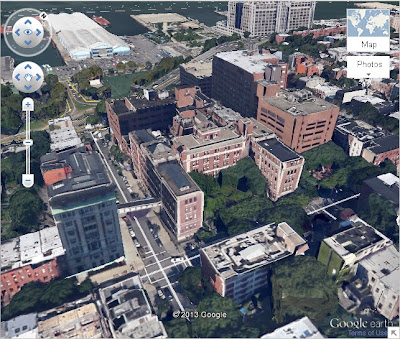


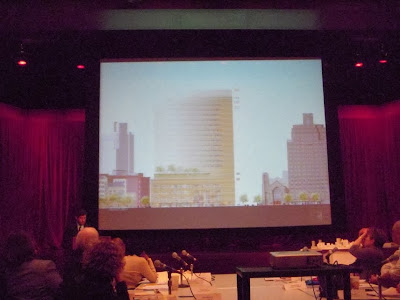







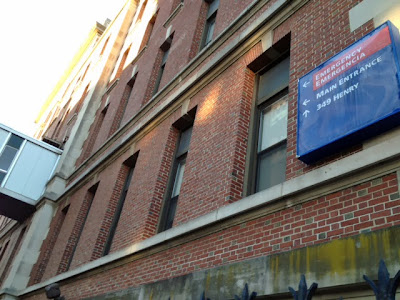



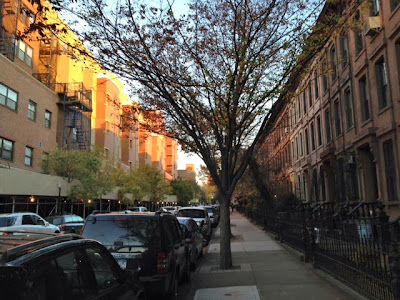






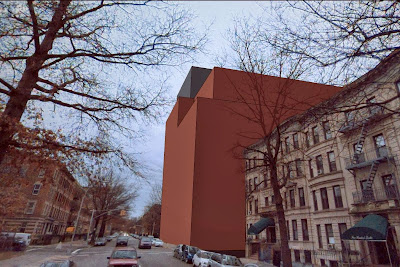
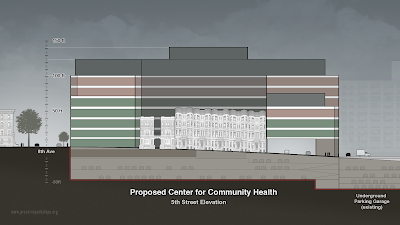


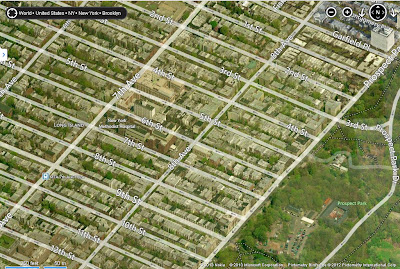






























 -
-










































Extell.jpg)



